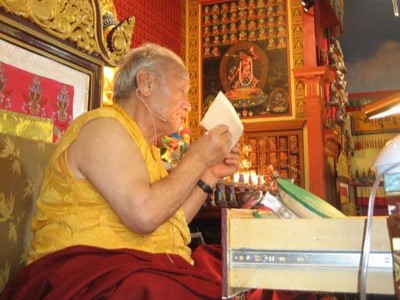Preserving the Sakya Tibetan Buddhist Heritage for future generations
From The Archives – Dharma Lecture Feb 2006

Brief Dharma Lecture by H.H. Dagchen Sakya Rinpoche Dorje Chang
February 12, 2006
Motivation for Practice
Translator: Dr. Jeffrey Schoening
Transcribed by Ogyen Choezom
We gather here at the Monastery in order to do wholesome activities, and also to put aside unwholesome activities. And to better understand the two. And we come here to practice the Dharma, the Buddha’s teaching.
Dharma can refer to Buddha’s teaching but can also just refer to worldly activities. There’s worldly activities, and then there’s the teachings of the Buddha. And these can both be referred to as Dharma.
So, at the beginning of the practice of Dharma, motivation is very important.
In our text, we have the phrase… “Homage to you who perceiving that the activities of samsara are insubstantial”.
And this is the important recognition that then informs our motivation, that enables us to do our practice. So, this is our starting point.
And then, as Buddhists, we take refuge. And there are three objects in which we take refuge. We take refuge in the Buddha, the Dharma, and the Sangha. And so these are the Three Jewels or the Triple Gem. And we are the ones, as individuals, who take refuge.
As Rinpoche said, samsara has no essence, and this teaching could be also understood through the teaching of the three types of endlessnesses. Such as, there is no end to activities, there is no end to desires, and there is no end to birth and death. So, contemplating these helps us better understand how samsara has no essence.
And so, recognizing the nature of samsara, we take refuge in the Buddha, Dharma, and Sangha. And by taking refuge, we can receive their blessing, the blessing of the Triple Gem. And this helps us on our path to understanding.
So, we read and recited the Praise of the 12 Exemplary Deeds of the Lord Buddha. We did it first in Tibetan, and then in English. So, we have a sense of the life of Buddha. And to better understand the Buddha, then it’s important to better understand his qualities. And to help us with this, there are the 10 powers of a Buddha.
So, these are in the Ocean of Compassion book, on page 45, they have a listing of these 10 spiritual powers of a Tathagata, that is a Buddha. As defined by the great Sakya Pandita, in his text, Elucidating the Intentions of the Sage, these 10 abilities are:
- Knowing what is possible and impossible.
- Knowing the karmic results of actions.
- Knowing the nature of various elements of existence.
- Knowing the various dispositions of living beings.
- Knowing the higher and lower faculties of living beings.
- Knowing the application of the path in every situation.
- Knowing the condition of all states, such as concentration, liberation, meditation, defilement, and purity.
- Knowing previous lives.
- Knowing through divine vision, death, transference, and birth.
- Knowing when the defilements are exhausted.
Link to audio recording: https://www.sakya.org/2009/12/chenrezi-teaching-2-12-2006/